Samsung R7 Review
Samsung R7
Exclusive: Samsung redefines multiroom audio with its stunning 360º speaker
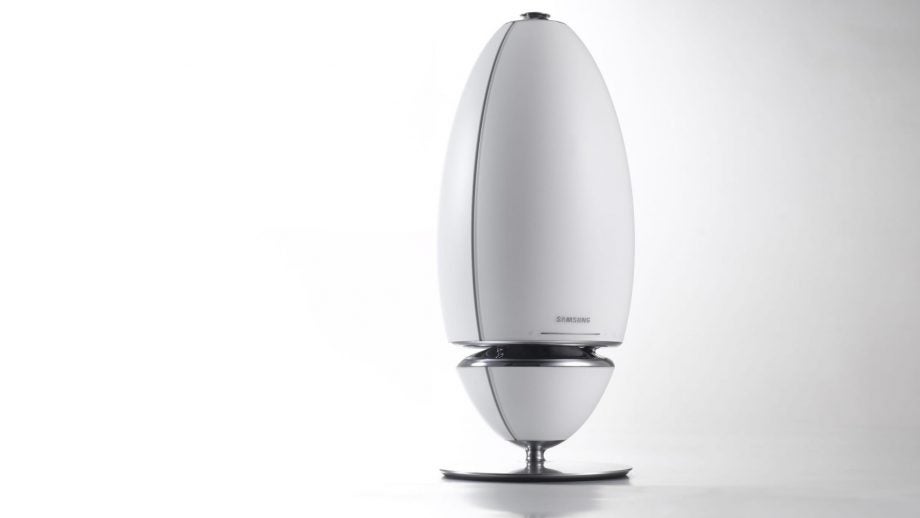
Verdict
Pros
- Gorgeous design and superb build quality
- Easy to setup and operate with new app
- Crisp and full-bodied sound from any direction
- Generous features
Cons
- Expensive
- Bass depth affected by height
- Some bugs in app
Key Specifications
- Review Price: £499.00
- Omnidirectional sound with Ring Radiator technology
- Bluetooth 4.0
- High-resolution audio support
- Hub-free Multiroom playback via Wi-Fi
- Access to online music streaming services through app
What is the Samsung R7?
Let’s face it, very few of us actually sit down in front of our speakers and listen to music as hi-fi doctrine dictates. We’re walking about, doing the dishes, lying in bed, getting dressed – activities that take us outside the sweet spot of a traditional speaker setup. As a result there are a growing number of speaker systems on the market that cater for these real-world listening habits.
SEE ALSO: Best Wireless Multiroom Speakers
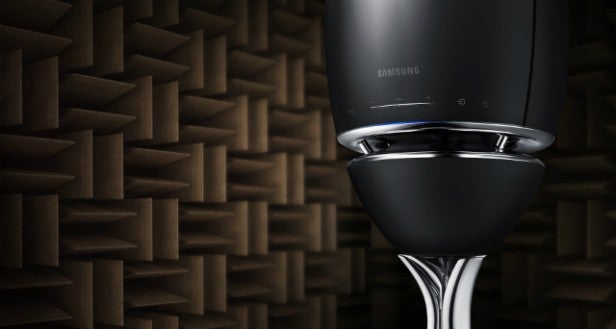
Samsung’s WAM7500, or R7 for short, is one such speaker. Developed in Samsung’s shiny new Audio Lab in Los Angeles, this multiroom and Bluetooth-ready speaker aims to deliver omnidirectional sound that maintains its quality no matter where you are in the room. Crystal Acoustics’ Cuby 7 recently explored the same principle with its WiSound system, but Samsung takes it to the next level with an egg-shaped design and Ring Radiator technology that disperses sound through 360º.
The R7 ushers in some other big changes. Samsung has revamped its smartphone app with a funkier and more intuitive layout and ditched the Hub used by last year’s speakers.
SEE ALSO: What is Hi-Res Audio?
Samsung R7 – Design and Connections
Last year’s M3, M5 and M7 were good looking speakers with some unique aesthetic flourishes, but the R7 knocks them all into a cocked hat. Samsung has really pushed the boat out here, dreaming up something that not only works as a speaker but also as a cutting-edge ornament for your living room. Samsung designed it to blend in with your décor but it’ll more likely be the first thing anyone notices when they walk in the room.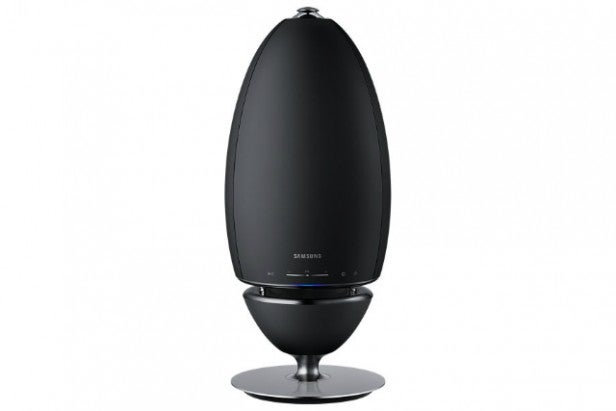
The R7’s design is unusual and striking. It’s shaped like a big egg, clad in resin with a soft-touch outer coating and perched on a swanky circular chrome base (which is a real fingerprint magnet). There are no visible speaker drivers – all you can see is a raised ‘Acoustic Lens’ over the upward-firing 25mm tweeter and a thin gap towards the bottom of the egg.
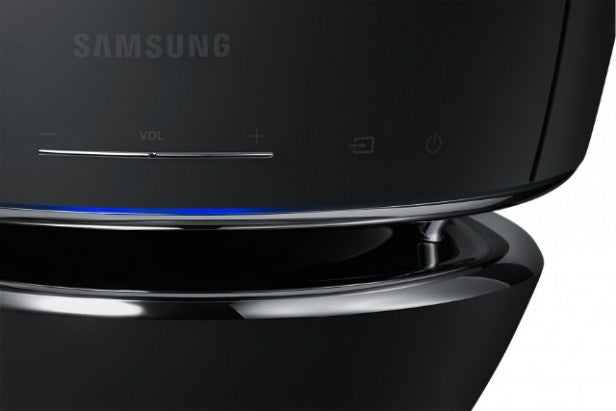
This gap is key to the R7’s performance. It’s part of Samsung’s patented Ring Radiator technology, where sound from the downward-firing 5in woofer is dispersed through the gap and spread evenly into the room.
This approach – which applies the same acoustic principles as Samsung’s latest flatpanel TVs – is designed to deliver the same sound quality no matter where you are in the room. It also means (theoretically) you can place it anywhere you like without worrying about sweet spots or proximity to rear walls.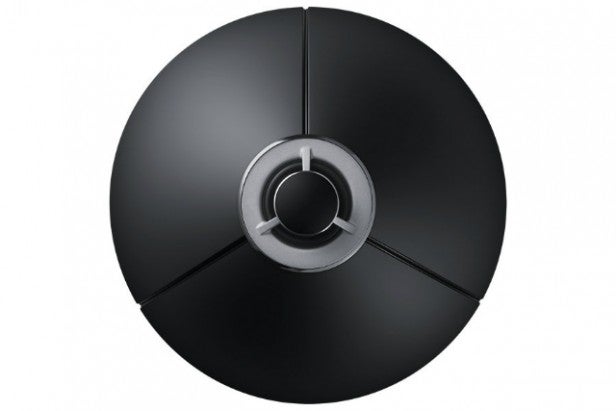
Also impressive is the Samsung R7’s luxurious build quality. The bodywork is hefty and robust, built from high-quality materials across the board. It may cost more than most multiroom speakers, but it’s obvious where the extra money has gone.
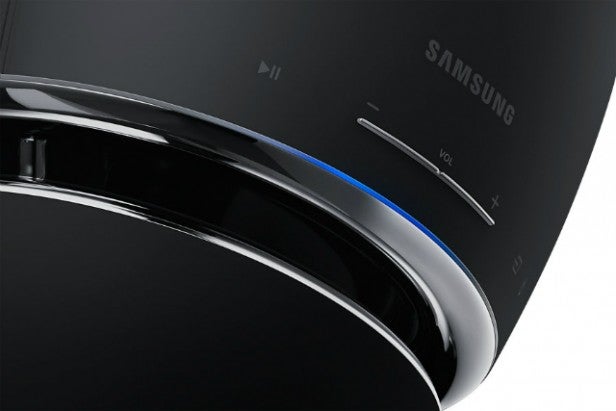
There are some nifty details like the discreet touch controls (including volume, play/pause, input, standby), a subtle status light and rounded chrome trim lining the Ring Radiator slot (which fires the sound outwards), all of which add to the R7’s allure. Samsung sent us two samples – one black, one white – but picking the prettiest is like choosing which one of your kids you like best.
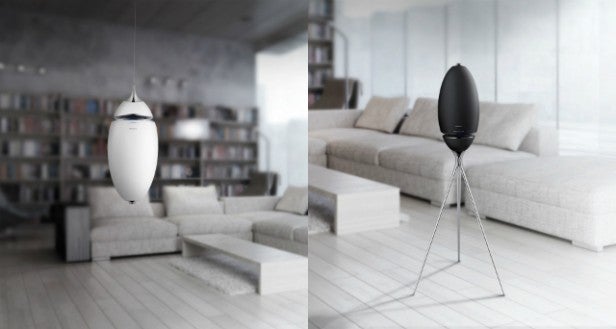
And if you thought the Samsung R7 couldn’t get any cooler, try hanging it from the optional ceiling mount or placing it on the tripod stand, the latter resembling the aliens from Spielberg’s War of the Worlds. Either way, it’s a bold style statement.
Remove the base with a coin and you’ll uncover a recess on the bottom, which houses the mains input and a mini USB port for service use. The mains lead feeds through the hole in the base and runs through a groove on the bottom, keeping it nice and tidy.
On the downside, the R7 is so staunchly dedicated to wireless audio that there are no inputs for old-school audio devices. That won’t be a problem for most people though, and wires poking out the side would seriously ruin the aesthetic anyway.
SEE ALSO: Best DAB Radios
Samsung R7 – Features
As you’d expect from Samsung’s flagship speaker, the R7 is teeming with features. Of course, the main attraction is ‘Ambient Audio’ technology, but the other big feature is the Multiroom App 2.0, which boasts a revamped interface and several new features – but we’ll come to that in ‘Operation’.
The R7’s multiroom functionality allows you to send music to other Samsung speakers around the house (including its latest TVs, soundbars and home cinema systems) or pair up multiple R7s in a stereo or even five-channel configuration. Two R7s could even be used as rear speakers with a Samsung soundbar to achieve true 5.1 sound.

Music can come from a variety of sources – tracks stored locally on your smartphone, devices on your home network or a variety of streaming services, including Spotify, Deezer, JUKE, Murfie, Napster, Qobuz, 7digital and 8tracks. Internet radio is provided by TuneIn and Rdio. It’s an impressive line up that puts some multiroom speakers to shame, although there’s no sign of TIDAL yet.
Elsewhere the Samsung R7 offers support for Bluetooth 4.0 and TV SoundConnect, playback of high-resolution audio files up to 192kHz/24-bit and dual-band Wi-Fi (2.4 / 5GHz).
Samsung R7 – Operation
Setting up and using the R7s couldn’t be easier, and that’s down to two things – the removal of the Hub used by last year’s multiroom speakers and the redesigned app.
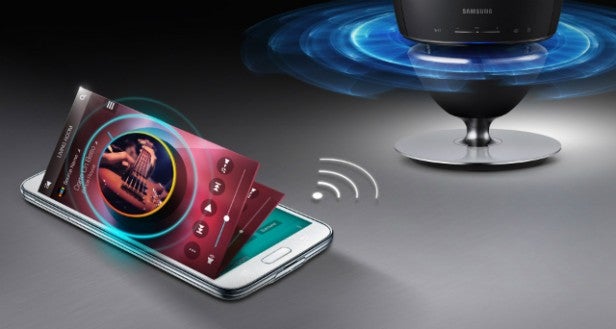
Eliminating the Hub is a smart move. It saves you money and means you don’t have to faff about connecting Ethernet cables to your router. Now, the R7 connects directly to your Wi-Fi network, making the installation process even quicker. But if you’re adding the R7 to an existing Hub-based ecosystem, rest assured that it’ll slot right in.
Turn on the speaker(s), run the multiroom app on your iOS or Android device, then enter your Wi-Fi password into the dialogue box when it appears. Once connected, it finds any available speakers and a female voice confirms the connection. This voice also pipes up when you switch inputs or pair a Bluetooth device.
We’re really impressed by the revamped Multiroom app. Visually it’s light years ahead of last year’s effort, using a more sophisticated colour palette and fancier fonts. But there are some lovely new features too. Our favourite is the Wheel Dial that lets you skip through tracks in the current album or playlist, and we love the way the screen changes colour to match cover art.

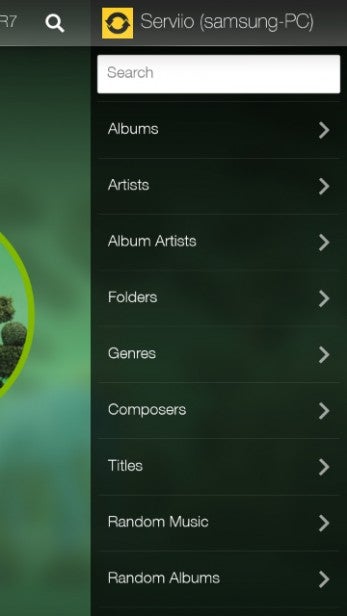
Other useful new features include a search engine that looks for songs by keyword on all connected sources; a widget control function that saves you having to fire up the full app; and a queuing function that makes it easy to create your own playlist. It all works so seamlessly – you can tell Samsung has put a lot of care into it.
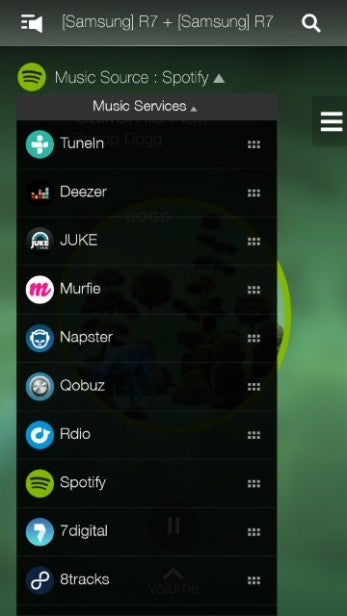
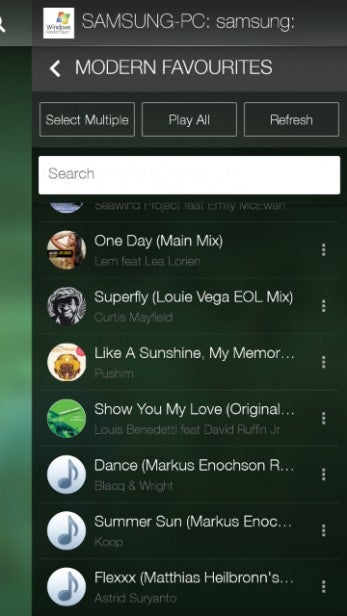
Although the architecture bears some resemblance to the previous version, it’s been streamlined in crucial areas. For example, the process of switching between music sources is now simply a case of selecting the drop-down menu at the top of the Now Playing screen. This menu lists Nearby Devices, Music Services and Other Music Sources.
It’s also easier to switch back to the speaker list – just tap the top of the screen – and to view the playback queue all you need to do is swipe your finger from the right of the screen.
Play a track from Spotify and its cover art is displayed within the multiroom app, although sadly the Wheel Dial function is disabled and you can only pause the song – to skip tracks you have to visit the Spotify app itself. Better integration is needed here.
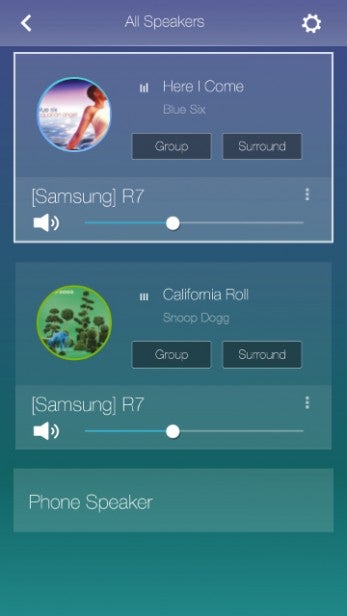
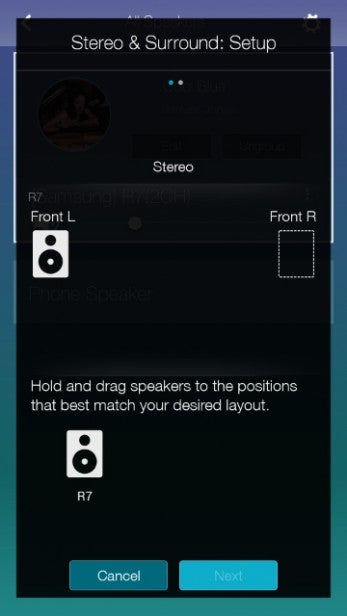
The speaker list works in the same way as before. Each multiroom speaker is displayed in a box with its own volume control and two options – Group and Surround. Hit Group and you can play the same music through all speakers, while Surround lets you arrange speakers in a stereo or multichannel system by dragging icons to the desired position. It works well, streaming music without any delays or drop-outs.
At present you can’t tweak the EQ for a group of speakers simultaneously, but Samsung says this will be enabled in a future update. Something else to bear in mind is that you can’t send Bluetooth music to other speakers in the system as you can with Crystal Acoustics’ Cuby 9, just the one it’s paired with.
The app is generally slick and intuitive, much more so than the previous version, but like any new software it’s a little buggy in places. It sometimes displayed the wrong track and cover art, while servers occasionally disappeared from the source list with no explanation. We’re sure stuff like this will be ironed out in future updates.
Samsung R7 – Performance
After playing a wide range of music from various sources, we’re pleased to report that the R7 is an excellent performer, improving on last year’s M series while fulfilling its promise of 360º sound.
We’ll get to the R7’s omnidirectional performance in a moment, but general sound quality is hugely impressive. It’s lively, powerful and takes loud volumes in its stride, but there’s also a lovely sense of balance and openness that you don’t always get from Samsung. 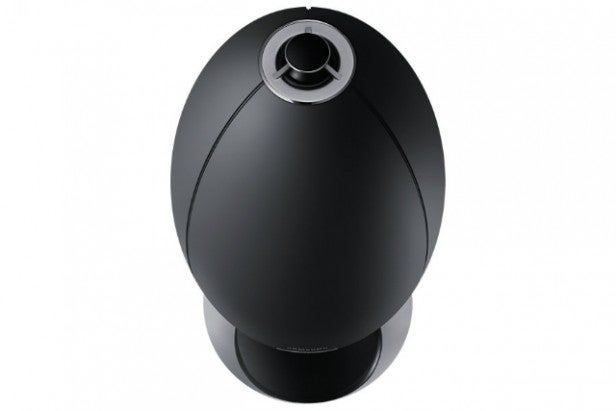
Its previous systems have either drowned you in tubby bass or assaulted your eardrums with brash mids, so it’s pleasing to hear the R7 producing a relatively transparent sound where no particular frequency group dominates.
It’s authoritative and articulate, and wouldn’t be provoked into harshness even with some eardrum-bothering EDM.
The 5in woofer musters a healthy amount of beefy bass, making the aggressive drums of Very First Breath by Hudson Mohawke slam hard. Each kick drum beat is tight and punchy, with no overhang to interfere with the R7’s sense of timing and rhythm. Can’t Feel My Face by The Weeknd sounds big and full bodied, with a thick bassline and enthusiastically conveyed drums. It’s a highly entertaining listen.
At the other end of the spectrum the R7’s smooth, crisp high-frequencies result in an open sound. The fluttering hats and double bass twang of Man on the Train by Jason Rebello are incisive, plus there’s a breathy texture to the lead singer’s voice.
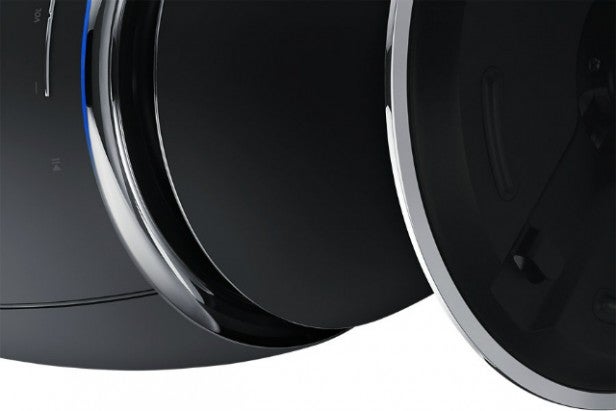
The much-vaunted omnidirectional sound is no empty promise. After placing the R7 on a waist-high table and going walkabout, sound quality remained consistent regardless of our position. Treble loses none of its crispness and we didn’t notice a significant drop in midrange clarity or dynamics. It also has the puff to fill a large room fairly comfortably.
There are a couple of minor issues though – bass loses a little depth and punch when it’s placed below ear level. As a result you need to experiment with different heights to get the best out of it, but it’s certainly not a deal breaker.
And naturally the R7’s diffuse dispersion lacks the focus and directionality to achieve a convincing stereo image – we tried two R7s in a stereo pair but staging was vague and instruments weren’t placed with any great accuracy. If that’s what you’re after, try a traditional speaker system – the R7 is a different animal altogether.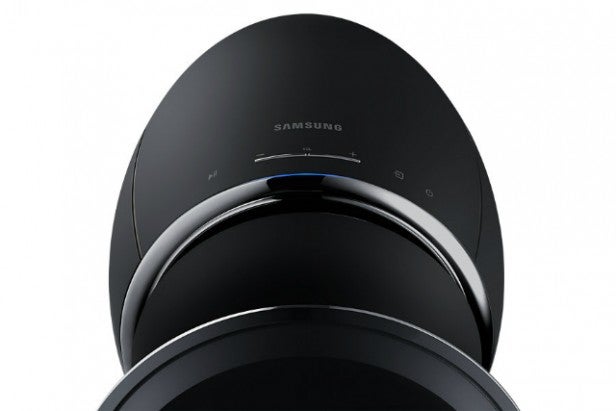
Should I buy the Samsung R7?
The Samsung R7 is expensive, but spend some time in its company and you realise it’s worth every penny. Build quality is first class while its delectable design will be a living room talking point.
We love the hub-free setup and revamped app, which is more intuitive than the previous version and works with admirable slickness and flexibility. But the icing on the cake is its dynamic and well-balanced sound, which can be enjoyed anywhere in the room thanks to the impressive omnidirectional technology.
It’s probably not the best sounding wireless speaker around – both the Clint Odin and Raumfeld Stereo Cubes are a little more polished – but when you take its generous features, usability and design into account the R7 adds up to an irresistible proposition that’s worthy of top marks.
SEE ALSO: Best Music Streaming Services
Verdict
Samsung has a real hit on its hands with the R7, a stylish, innovative and great-sounding speaker that takes multiroom technology to new heights

